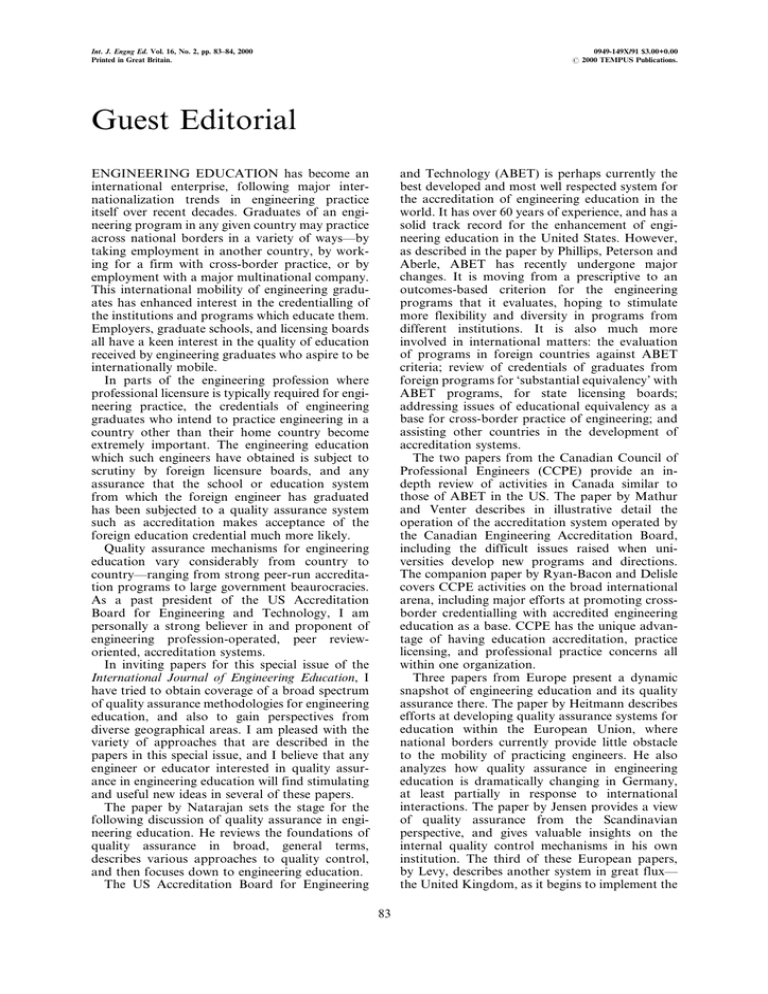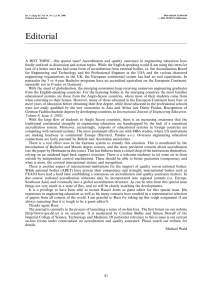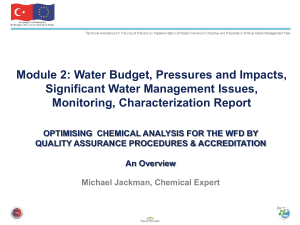Guest Editorial
advertisement

Int. J. Engng Ed. Vol. 16, No. 2, pp. 83±84, 2000 Printed in Great Britain. 0949-149X/91 $3.00+0.00 # 2000 TEMPUS Publications. Guest Editorial and Technology (ABET) is perhaps currently the best developed and most well respected system for the accreditation of engineering education in the world. It has over 60 years of experience, and has a solid track record for the enhancement of engineering education in the United States. However, as described in the paper by Phillips, Peterson and Aberle, ABET has recently undergone major changes. It is moving from a prescriptive to an outcomes-based criterion for the engineering programs that it evaluates, hoping to stimulate more flexibility and diversity in programs from different institutions. It is also much more involved in international matters: the evaluation of programs in foreign countries against ABET criteria; review of credentials of graduates from foreign programs for `substantial equivalency' with ABET programs, for state licensing boards; addressing issues of educational equivalency as a base for cross-border practice of engineering; and assisting other countries in the development of accreditation systems. The two papers from the Canadian Council of Professional Engineers (CCPE) provide an indepth review of activities in Canada similar to those of ABET in the US. The paper by Mathur and Venter describes in illustrative detail the operation of the accreditation system operated by the Canadian Engineering Accreditation Board, including the difficult issues raised when universities develop new programs and directions. The companion paper by Ryan-Bacon and Delisle covers CCPE activities on the broad international arena, including major efforts at promoting crossborder credentialling with accredited engineering education as a base. CCPE has the unique advantage of having education accreditation, practice licensing, and professional practice concerns all within one organization. Three papers from Europe present a dynamic snapshot of engineering education and its quality assurance there. The paper by Heitmann describes efforts at developing quality assurance systems for education within the European Union, where national borders currently provide little obstacle to the mobility of practicing engineers. He also analyzes how quality assurance in engineering education is dramatically changing in Germany, at least partially in response to international interactions. The paper by Jensen provides a view of quality assurance from the Scandinavian perspective, and gives valuable insights on the internal quality control mechanisms in his own institution. The third of these European papers, by Levy, describes another system in great fluxÐ the United Kingdom, as it begins to implement the ENGINEERING EDUCATION has become an international enterprise, following major internationalization trends in engineering practice itself over recent decades. Graduates of an engineering program in any given country may practice across national borders in a variety of waysÐby taking employment in another country, by working for a firm with cross-border practice, or by employment with a major multinational company. This international mobility of engineering graduates has enhanced interest in the credentialling of the institutions and programs which educate them. Employers, graduate schools, and licensing boards all have a keen interest in the quality of education received by engineering graduates who aspire to be internationally mobile. In parts of the engineering profession where professional licensure is typically required for engineering practice, the credentials of engineering graduates who intend to practice engineering in a country other than their home country become extremely important. The engineering education which such engineers have obtained is subject to scrutiny by foreign licensure boards, and any assurance that the school or education system from which the foreign engineer has graduated has been subjected to a quality assurance system such as accreditation makes acceptance of the foreign education credential much more likely. Quality assurance mechanisms for engineering education vary considerably from country to countryÐranging from strong peer-run accreditation programs to large government beaurocracies. As a past president of the US Accreditation Board for Engineering and Technology, I am personally a strong believer in and proponent of engineering profession-operated, peer revieworiented, accreditation systems. In inviting papers for this special issue of the International Journal of Engineering Education, I have tried to obtain coverage of a broad spectrum of quality assurance methodologies for engineering education, and also to gain perspectives from diverse geographical areas. I am pleased with the variety of approaches that are described in the papers in this special issue, and I believe that any engineer or educator interested in quality assurance in engineering education will find stimulating and useful new ideas in several of these papers. The paper by Natarajan sets the stage for the following discussion of quality assurance in engineering education. He reviews the foundations of quality assurance in broad, general terms, describes various approaches to quality control, and then focuses down to engineering education. The US Accreditation Board for Engineering 83 84 Russel C. Jones recommendations of a major profession wide study that will bring engineering education in the UK to a longer program of study than previously was standard. Levy also describes major changes in the structure of the government-supported education system for engineers in the UK, and how quality assurance is applied currently. Two papers from the Pacific Rim illustrate engineering education and accreditation developments in that region of the world. Webster describes a major restudy of engineering education and the practice for which it prepares graduates in Australia, and how it is changing the shape of education there. He also covers in useful depth the system of accreditation for engineering programs operated by the profession of engineering. Kwok reviews the status of engineering education in Hong Kong, and describes the quality assurance system in place there. He also indicates the increasing role of international interaction among engineering organizations, and the mutual recognition agreements that are necessary for mobility of graduates. The final two papers provide insights on engineering education and its quality assurance in developing countries in very different parts of the world. Issa describes experience in Jordan with the rapid growth in the number of private, for-profit, universities offering engineering programsÐdue to the inability of public universities to fund expansion to meet increased demand. He reviews a system of accreditation which has been established to assure that such for-profit institutions provide at least a minimum of quality education for their students. In the final paper, Ocampo describes the development of a new engineering education accreditation system in Mexico, necessitated by the need to assure the quality of graduates given the opportunity for crossborder practice due to international free-trade agreements. In all, I believe that the reader of this special issue of IJEE will obtain an in-depth and balanced perspective on engineering education around the world today, and how its quality and improvement are insured. Granted that this is a snapshot in time in a dynamic world, it provides a good base for understanding current status and for following future trends in engineering education and its quality assurance. Russel C. Jones Russel Jones is a private consultant, working through World Expertise Ltd., to offer services to a select clientele. Until recently he served as Executive Director of the National Society of Professional Engineers in the US. Dr Jones received his education at Carnegie Institute of Technology, earning degrees in civil engineering and materials science. Prior to returning to Carnegie for his doctoral study, he worked as a practicing civil engineer. He has spent much of his career as an educator, starting with engineering education and broadening to higher education as a whole. After completing his doctoral degree in 1963, he taught for eight years on the faculty of the Massachusetts Institute of Technology. He then served in a succession of administrative posts in higher education, for several years each: Chairman of Civil Engineering at Ohio State University, Dean of Engineering at the University of Massachusetts, Academic Vice President at Boston University, and President and University Research Professor at the University of Delaware. He has many publications, honors and awards, and professional offices and activities to his credit.






